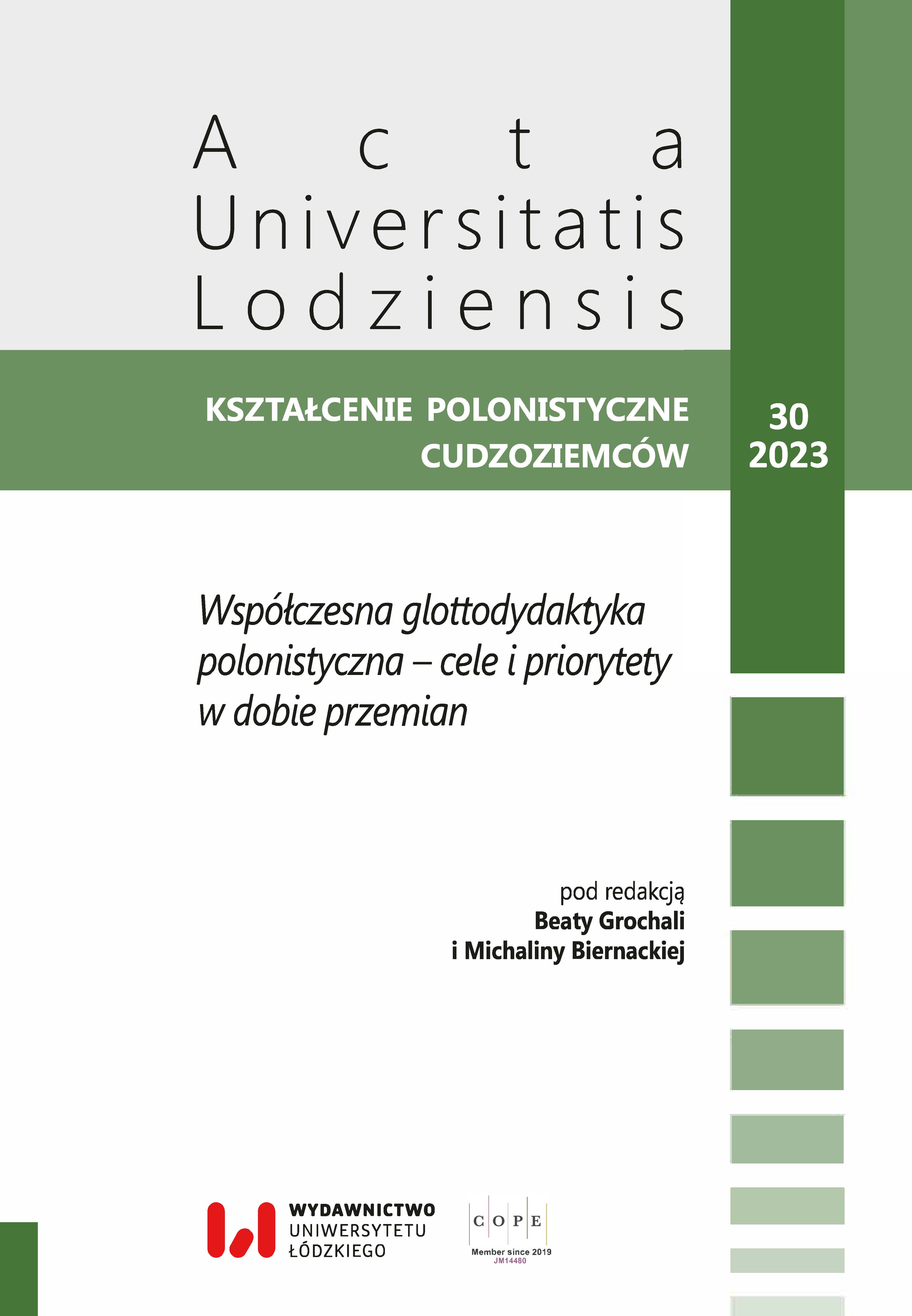Jak logopeda może wspomagać rozwój kompetencji językowych i komunikacyjnych dziecka uczącego się jpjo/jpj2 (w odniesieniu do dzieci z Ukrainy)
DOI:
https://doi.org/10.18778/0860-6587.30.20Słowa kluczowe:
logopedia, kompetencje językowe, kompetencje komunikacyjne, język polski jako obcyAbstrakt
Obywatele Ukrainy są zdecydowanie najliczniejszą grupą cudzoziemców w Polsce, stanowiąc nieco ponad 80% ogółu osiedlających się w kraju obcokrajowców. Jednym ze skutków ruchów migracyjnych do Polski, związanych przede wszystkim z obecną sytuacją w Ukrainie, jest zwiększająca się liczba dzieci ukraińskich w przedszkolach, szkołach podstawowych czy średnich. Ruchy migracyjne determinujące kontakty językowo-kulturowe, których efektem jest zjawisko dwu- lub wielojęzyczności, stawiają przed logopedami i terapeutami nowe zadania, a dwujęzyczność (wielojęzyczność) zdecydowanie wpisała się w krąg zainteresowań logopedycznych. Celem artykułu jest usystematyzowanie, na podstawie literatury przedmiotu oraz własnych doświadczeń, kompetencji logopedy w zakresie wspomagania dzieci ukraińskich uczących się języka polskiego jako obcego/jako drugiego, omówienie logopedycznych form wsparcia tych dzieci oraz wskazanie wyzwań, jakie stoją przed współczesną logopedią w omawianym zakresie. Logopeda w ramach wsparcia przede wszystkim przeprowadza proces diagnostyczny i stawia diagnozę (rozpoznanie logopedyczne) dziecka bilingwalnego, ustala strategie rozwijania sprawności językowych i komunikacyjnych, rozwija sprawności językowe i komunikacyjne dziecka, poprzez ćwiczenia językowych sprawności systemowych i komunikacyjnych. Aby wsparcie logopedy w procesie nauczania języka polskiego jako obcego/jako drugiego było najskuteczniejsze, logopeda powinien mieć dostęp do wystandaryzowanych i znormalizowanych, rzetelnych narzędzi diagnostycznych przeznaczonych dla osób bilingwalnych oraz stworzone procedury, metody i narzędzia niezbędne do procesów terapii logopedycznej osób dwu-/wielojęzycznych, a to jest najważniejszym zadaniem stojącym przed współczesną logopedią.
Bibliografia
Błasiak-Tytuła M., 2018, Wczesne wspomaganie rozwoju mowy dziecka dwujęzycznego. Profilaktyka logopedyczna w sytuacji dwujęzyczności klasycznej, w: M. Błasiak-Tytuła, A. Siudak (red.), Neurologopedia. Neurobiologiczne podstawy wczesnej terapii zaburzeń rozwojowych, Kraków, s. 95–111.
Google Scholar
Błasiak-Tytuła, M., 2019, Mowa dzieci dwujęzycznych. Norma i zaburzenia, Kraków.
Google Scholar
Caesar L., Kohler P., 2007, The state of school-based bilingual assessment: Actual practice versus recommended guidelines, „Language, Speech and Hearing Services in Schools”, t. 38 (3), s. 190–200.
Google Scholar
DOI: https://doi.org/10.1044/0161-1461(2007/020)
Cieszyńska J., 2006, Dwujęzyczność, dwukulturowość – przekleństwo czy bogactwo? O poszukiwaniu tożsamości Polaków w Austrii, Kraków.
Google Scholar
Cieszyńska J., 2007, Od zabawy i nauki czytania do systemu językowego. Od języka do społeczności, „Logopedia”, t. 1(4), s. 6–29.
Google Scholar
Cieszyńska-Rożek J., 2010, Dwujęzyczność - rozumienie siebie jako Innego, w: J. Cieszyńska, Z. Orlowska-Popek, M. Korendo (red.), Nowe podejście w diagnozie i terapii logopedycznej – metoda krakowska, Kraków, s. 18–36.
Google Scholar
Cieszyńska-Rożek, J., 2012, Rozwój mowy polskich dzieci na obczyźnie – zjawiska normatywne czy zaburzenia rozwojowe?, w: M. Michalik, A. Siudak, Z. Orłowska-Popek (red.), Diagnoza różnicowa zaburzeń komunikacji językowej, Kraków, s. 67–82.
Google Scholar
Cieszyńska-Rożek J., 2013, Metoda Krakowska wobec zaburzeń rozwoju dzieci. Z perspektywy fenomenologii, neurobiologii i językoznawstwa, Kraków.
Google Scholar
Cieszyńska-Rożek J., 2016, Glottodydaktyka i logopedia (metoda krakowska), w: I. Janowska, P.E. Gębal (red.), O lepsze jutro studiów polonistycznych w świecie: glottodydaktyka polonistyczna dziś, Kraków, s. 87–99.
Google Scholar
Cieszyńska J., Korendo M., 2017, Wczesna interwencja terapeutyczna. Stymulacja rozwoju dziecka od noworodka do 6. roku życia, Kraków.
Google Scholar
Czaplewska E., 2018, Rola logopedii we współczesnych społeczeństwach wielokulturowych, w: E. Czaplewska (red.), Logopedia międzykulturowa, Gdańsk, s. 261–281.
Google Scholar
Grabias S., 1994, Język w nauczaniu niesłyszących. Zasady programowania systemu komunikacyjnego, w: S. Grabias (red.), Głuchota a język, Lublin, s. 185–221.
Google Scholar
Grabias S., 1997, Mowa i jej zaburzenia, „Audiofonologia”, t. 10, s. 9–36.
Google Scholar
Grabias S., 2012, O ostrość refleksji naukowej. Przedmiot logopedii i procedury logopedycznego postępowania, w: S. Milewski, K. Kaczorowska-Bray (red.), Logopedia. Wybrane aspekty historii, teorii i praktyki, Gdańsk, s. 56–69.
Google Scholar
Kilińska-Ewartowska E., 1978, Logorytmika, Lublin.
Google Scholar
Matsumoto D. Juang L., 2007, Psychologia międzykulturowa, Sopot.
Google Scholar
Młyński R., 2012, Dwujęzyczność dziecięca w perspektywie glottodydaktyki i logopedii. Próba syntezy, w: M. Michalik, Z. Orłowska-Popek, A. Siudak (red.), Nowa Logopedia. Diagnoza różnicowa zaburzeń komunikacji językowej, t. 3, Kraków, s. 93–111.
Google Scholar
Młyński R., 2021a, Ocena dwujęzyczności dziecięcej przy zastosowaniu formuły RIOT, „Logopaedica Lodziensia”, nr 5, s. 159–170. https://doi.org/10.18778/2544-7238.05.10
Google Scholar
DOI: https://doi.org/10.18778/2544-7238.05.10
Młyński R., 2021b, Procedury diagnostyczne dzieci dwujęzycznych, „Forum Logopedy”, nr 44, s. 30–36.
Google Scholar
Młyński R., 2021c, The BID procedure as a tool for assessing phonological processes in bilingual children, “Logopedia Silesiana”, t. 10, nr 2, s. 1–13. https://doi.org/10.31261/LOGOPEDIASILESIANA.2021.10.02.02
Google Scholar
DOI: https://doi.org/10.31261/LOGOPEDIASILESIANA.2021.10.02.02
Młyński R., Redkva M., 2019, Diagnoza logopedyczna kompetencji językowych u wielojęzycznych dzieci z Ukrainy, „Logopedia Silesiana”, t. 8, s. 448–460. https://doi.org/10.31261/LOGOPEDIASILESIANA.2019.08.18
Google Scholar
DOI: https://doi.org/10.31261/LOGOPEDIASILESIANA.2019.08.18
Muszyńska B., Papaja K., 2019, Zintegrowane kształcenie przedmiotowo-językowe. Wprowadzenie, Warszawa.
Google Scholar
Rocławska-Daniluk M., 2020, Dwujęzyczność i wychowanie dwujęzyczne z perspektywy lingwistyki i logopedii, Gdańsk.
Google Scholar
Rittel T., 1994, Podstawy lingwistyki edukacyjnej. Nabywanie i kształcenie języka, Kraków.
Google Scholar
Wygotski L.S., 1989, Mózgowa organizacja czynności psychicznych, Warszawa.
Google Scholar
Wysocka M., 2018, Logorytmika, w: A. Domagała, U. Mirecka (red.), Metody terapii logopedycznej, Lublin, s. 651–670.
Google Scholar
Wysocka M., 2021, Zastosowanie piosenki we wspomaganiu rozwoju sprawności językowych, komunikacyjnych i poznawczych dziecka, „Logopedia”, t. 50/1, s. 143–156.
Google Scholar
https://samorzad.pap.pl/kategoria/edukacja/mein-w-polskich-szkolach-i-przedszkolach-jest-1879-tys-dzieci-i-mlodziezy-z [27.03.2023].
Google Scholar
https://www.gov.pl/web/udsc/obywatele-ukainy-w-polsce-aktualne-dane-migracyjne2 [27.03.2023].
Google Scholar
https://www.strazgraniczna.pl/pl/granica/statystyki-sg/2206,Statystyki-SG.html [27.03.2023].
Google Scholar
Opublikowane
Wersje
- 2023-12-07 - (2)
- 2023-12-07 - (1)
Jak cytować
Numer
Dział
Licencja

Utwór dostępny jest na licencji Creative Commons Uznanie autorstwa – Użycie niekomercyjne – Bez utworów zależnych 4.0 Międzynarodowe.










